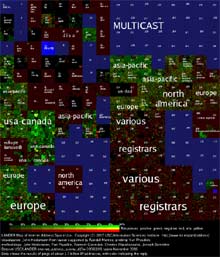
In a paper to be presented later this month at the Proceedings of the ACM Internet Measurement Conference, a team of six researchers have documented what they claim is the first complete census of the Internet in more than two decades. They discovered a surprising number of unused addresses and conclude that plenty will still be lying idle when the last numbers are handed out in a few years' time. The problem, they say, is that some companies and institutions are using just a small fraction of the many million addresses they have been allocated.
"People are very concerned that the IPv4 address space is very close to being exhausted," says John Heidemann, a research associate professor in the department of computer science at the University of Southern California (USC) and the paper's lead author. "Our data suggests that maybe there are better things we should be doing in managing the IPv4 address space."
The census, carried out every quarter since 2003 but only recently published, is the first comprehensive map of the Internet since David Smallberg, then a computer-science student at the University of California, Los Angeles, canvassed the Internet's first servers--all 300-plus of them--following the switchover from the ARPANET in early 1983.
Internet Protocol version 4 (IPv4) addresses are typically managed as network blocks consisting of 256 addresses (known as a C block), 65,536 addresses (known as a B block), or approximately 16.8 million addresses (known as an A block). About a quarter of the A block addresses--the largest segments of the Internet--were given out in the first days of the Internet to early participants and to companies and organizations including Apple, IBM, and Xerox.
Today, A blocks are issued by an organization called the Internet Assigned Numbers Authority (IANA) to large Internet service providers or to regional registrars to which the A blocks are resold. But because accelerating use of the Internet is quickly eating up the remaining free blocks of network addresses, the last blocks will likely be given out between the end of 2010 and 2011.
The next-generation Internet address scheme, IPv6, solves the shortage by vastly increasing the number of addresses available. While IPv4 offers about 4.3 billion addresses for the earth's 6.7 billion people, IPv6 will offer 51 thousand trillion trillion per person. However, the move to IPv6 has progressed slowly because of cost and complexity, even with recent mandates for use of IPv6 within the U.S. government.



Reader Comments
to our Newsletter